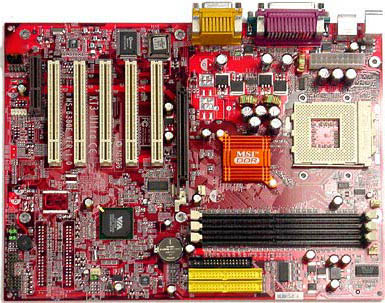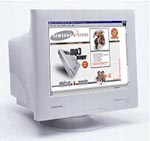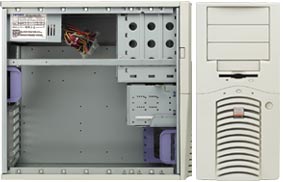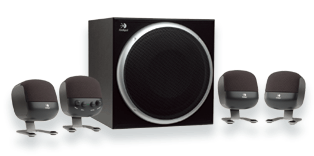
Original Link: https://www.anandtech.com/show/1000
Buyer's Guide: Value Gaming - September 2002
by Matthew Witheiler on September 25, 2002 12:00 PM EST- Posted in
- Guides
Of our seven buyer's guides, one of the most popular configurations is that of the budget gamer. This is likely so for a number of reasons. First off, determining what components go in a gaming system on a budget is not an easy task. Unlike high-end configurations, where a product's performance or feature set can distinguish it from others in the market, budget systems must be configured with components that balance performance with price. Secondly, consumers looking for the most bang for the buck are usually extra picky when it comes to where their money is spent. Ten dollars here or ten dollars there in a system that is upwards of $3,000 is not a big deal, but when the system price is down to sub $1,000 levels every penny counts. Finally, it is likely that our budget gaming buyer's guide is popular simply due to the fact that many of our readers are in the market for a system such as this.
What ever the reason that you read the value gaming buyer's guide, we hope that, like our our other buyer's guides, it provides you with valuable insight as to what is going on in the computer industry and makes deciding what goes in your system a bit easier. Our task in configuring a value gaming system is a difficult one: not only must we focus on building a system that can play the games of today and tomorrow, we are forced to pay attention to prices. The ultimate goal of the value gaming buyer's guide is to configure a system that provides the most (or close to the most) gaming bang for the buck.
Every component in a recommend system, from case to monitor, is covered. The only hidden costs are shipping costs, which can add anywhere from 5% to 10% to the total system cost depending on what you get and from where. The best way to keep shipping costs down is to order as much as possible from a single vendor or pick things up locally. Be sure to take a look at the AnandTech Hot Deals Forum to see if any AnandTech readers have posted a special deal on a piece of hardware in the recommended system. Also be sure to check out our Weekly CPU & Video Card Price Guide and our Weekly Memory & Motherboard Price Guide to see if prices have been updated since the buyer's guide was last posted.
This Week
Today we reevaluate our value gaming system. You may recall that we configured our last value gaming platform about seven weeks ago. At that time we put together what we thought to be a strong gaming system at a very nice price. As is usually the case with electronic components, the power of our value gaming system has only improved since we last took a look at it. Overall our current value gaming configuration shares many traits with the value gaming system recommended seven weeks ago, but some of the components have been upgraded or otherwise changed. On the whole, prices remained about the same, falling in some areas and rising in others.
Value Gaming
Processor - AMD Athlon XP 1700+ (1.47GHz) - $66
The prices in the low-end Athlon XP market have not altered much in the past seven weeks, forcing us to go with the same recommendation we made previously at only a slightly lower price.
The Athlon XP processor is a clear choice for any value gaming system. Gaming wise, the Athlon XP provides much more power than other processors in its price range. The price of the Athlon XP 1700+ fell only $2 in the seven weeks since our last value gaming buyer's guide and, sadly, none of the other Athlon XP processors shifted in price enough to make them a more viable option.
An additional $13 will upgrade your processor to the 1800+ (1.53GHz) but will only result in marginal performance gains thanks to the 66MHz clock speed boost. If you are looking to save a few bucks you can opt for the Athlon XP 1600+ (1.4GHz) for $12 less.
For more information about the Athlon XP 1700+ be sure to read our AMD Athlon XP article.
Motherboard - MSI MS-6380E KT3 Ultra2 - $80
Our last value gaming system recommended the MSI KT3 Ultra motherboard as the motherboard of choice. We decided upon the KT3 Ultra for a number of reasons. First, we were pleased at the price that the KT333 motherboard was being offered at (very close in price to the older KT266A motherboards). Secondly, we chose the KT3 Ultra because of its integrated 6 channel audio solution (provided by a Avance Logic ALC650 chip). Finally, we decided upon the KT3 Ultra because it won our Editors Choice Silver award in our KT333 roundup.
This time around we slightly modify our motherboard selection. Today we replace the KT3 Ultra with the updated KT3 Ultra2. The two are essentially the same motherboard except the KT3 Ultra2 now uses VIA's new southbridge solution, the VT8235, which adds USB 2.0 support. The board still maintains the quality build, stability, and integrated sound that got it here in the first place. The bottom line is that the KT3 Ultra2 is only $3 more than the KT3 Ultra was seven weeks ago and is the next logical step in the KT3 Ultra series evolution.

You can read more about the MSI KT3 Ultra in our KT333 roundup and more about the KT333 chipset in general in our VIA KT333 article.
Memory - 256MB Crucial PC2700 DDR SDRAM - $74
We again chose to outfit our value gaming system with PC2700 (DDR333) memory. Using this memory one can take full advantage of the KT333's 333MHz memory bus speed. The choice to go with PC2700 memory over PC2100 memory was based on the fact that PC2700 memory will help gaming performance slightly while not really altering the cost of the system all that much.
The Mushkin memory special that we recommend last value gaming buyer's guide is no more. This week we turn to Crucial to provide the memory for our value gaming system. The price is now $12 more than it was last week but you are still getting memory from a name brand manufacturer that backs their memory with a warrantee. Again, we caution you from getting memory from a no name producer. Motherboards, especially of the KT333 variety, can be very picky when it comes to what memory it will accept. Trust us, the extra cash it will cost to go with a Crucial, Mushkin, Kingston, ect memory module well offsets the pain of trying to figure out why your system is not POSTing.
Video Card - ATI Radeon 8500LE 64MB - $87
Deciding which video card to power our value gaming setup is the most difficult task of all. We are left with a number of options at a variety of price points meaning that the "best" choice is not always clear. However, with ATI attempting to flush the Radeon 8500LE out of market to make room for the Radeon 9000 Pro, the low price of the ATI Radeon 8500LE was too much to pass up.
There are only really a handful of performance video cards out there that are in the sub $100 range. These cards include the ATI Radeon 9000 Pro, the NVIDIA GeForce4 MX 460, the Matrox G550, and, of course, ATI Radeon 8500LE. In the sub $100 level it is pretty easy to rule out the Matrox card for its sub par performance. The NVIDIA GeForce4 MX 460 comes close to the Radeon 9000 Pro and 8500LE's performance but eventually falls to the Radeon thanks to its DirectX 8.1 functionality and superior speed (remember, the GeForce4 MX is only a DX7 chip).
Deciding between the new Radeon 9000 Pro and the aging Radeon 8500LE was not easy. Eventually we decided upon the Radeon 8500LE thanks to the fact that it outperforms the Radeon 9000 Pro in the majority of situations (read why here) at a price that is only $7 more. Plus, if you are willing to overclock your video card a bit, the Radeon 8500LE can be pushed to Radeon 8500 speeds and beyond in most cases. We can't be sure how long the 8500LE will remain in the market, but once it is gone only the Radeon 9000 Pro will remain a viable option for our value gaming system on the ATI side (baring any significant price drops).
If you have the cash to spare and would like a bit more 3D gaming performance, take a look at the NVIDIA GeForce4 Ti 4200 64MB. The GeForce4 Ti 4200 rings in at about $130, putting it $43 more than the Radeon 8500LE but it does offer a performance boost. Like the Radeon 8500LE, you will have your hands on one fast card is you are willing to overclock your GeForce4 Ti 4200 a bit. Since all GeForce4 Ti 4200 64MB cards are created equal, just go with the least expensive board you can find.
For more information about the Radeon 8500, check out one of our various ATI Radeon 8500 reviews.
Monitor - Samsung 955DF - $185
 A
19" or larger monitor was a must for our value gaming system. The system
that we are configuring here should have no problem running even intense 3D
games at resolutions of 1024x768 and above, making a high resolution monitor
a must. The system will also run a good number of games fast, meaning that we
can't have low refresh rates throughout the resolutions. The Samsung 955DF with
its recommended resolution of 1280x1024 at 80Hz proves to fit the bill.
A
19" or larger monitor was a must for our value gaming system. The system
that we are configuring here should have no problem running even intense 3D
games at resolutions of 1024x768 and above, making a high resolution monitor
a must. The system will also run a good number of games fast, meaning that we
can't have low refresh rates throughout the resolutions. The Samsung 955DF with
its recommended resolution of 1280x1024 at 80Hz proves to fit the bill.
The 955DF is now fairly inexpensive as far as 19" monitors go. The monitor is $45 less expensive this value gaming buyer's guide and can now be had for $185.
You are fairly safe going with any name-brand 19" monitor, be it from Samsung, MAG, Sony, ect. We chose to go with the 955DF simply because we have had personal experience with it.
Be sure to check out our Samsung 955DF 19" Monitor review for more information.
Case - Antec SX630 - $75
The Antec SX630 is a case we have been recommending for quite some time now in our value system configurations. The SX630 is a mini tower case solution that offers 8 drive bays (five 3.5" bays and three 5.25" bays), seven expansion slots, a swing-out side panel, and an 80mm rear case fan standard. Cooling-wise, the SX630 can also accept two front mounted 80mm case fans. The SX630's 300 watt AMD approved power supply should have no problem with our KT333 motherboard and Athlon XP 1700+ processor.

Sound Card - Integrated 6 Channel Avance Logic ALC650 - "Free"
We found in a recent on-board audio test that the 6 channel Avance Logic ALC650 AC'97 codec makes the need for a discrete sound card in a value system no longer necessary. Luckily, the MSI KT3 Ultra2 that is at the heart of our value gaming setup makes use of the ALC650, providing a very low cost 6 channel audio solution that provides audio functionality not previously available in an integrated audio chip.
Avance Logic's software allows you to remap the three 1/8" jacks on the KT3 Ultra2 to handle front, rear and LFE outputs. Because of this, these three jacks enable 5.1 channel analog outputs without the use of any additional brackets. The audio quality of this solution should be just about as good as a high end discrete audio card with a price much more attractive: free.
Check out our page covering onboard audio in our KT333 roundup for more information.
Speakers - Logitech Z-540 - $57
Audio quality in a gaming system is of utmost importance. Hearing shots coming from the left side of the screen just does not sound right on your typical pair of $20 stereo speakers. Although a 5.1 audio setup is ideal, going with a 4.1 setup in our value gaming system seemed to make the most sense.
The Logitech Z-540 speakers make for an excellent 4.1 speaker setup at a very tempting price. The dedicated sub and rear speakers will certainly help bring any 3D game to life. You can save a $20 or so by going with a 2.1 speaker setup if you are on a very tight budget. Then again, those out there with a more lax budget may opt to go for the Logitech Z-560's.

Ethernet - Linksys EtherFast 10/100 - $20
We have been recommending the Linksys EtherFast 10/100 network card for what seems like ages now. We continue to stick with the card because of our personal experience with it. We have been using EtherFast 10/100 cards in the lab for years now and have never been disappointed. Plus, the card offers full support for all major OS's.
Hard Drive - Western Digital WD400BB 40GB - $70
Recently Western Digital has been producing the fastest IDE hard drives on the market. The company's performance and special edition lines offer great performance at prices that are comparable with other drives. The WD400BB drive that we chose to outfit our value gaming system with is one of the company's "high performance" drives. The name is worthy, being that you will be hard pressed to find a faster 7200RPM IDE hard drive. In fact, the WD400BB only falls behind the "special edition" WDx00JB drives when it comes to performance (thanks to the JB's 8MB of cache). At $70, the 40GB WD400BB makes the most sense for our value gaming system. If you are looking for even more performance, another $20 will get you the same drive with the 8MB buffer.
For those wanting more space, the 60GB WD600BB runs about $85 and the 80GB WD800BB is selling at $95.
CD-R/CD-RW - Name Brand 24x10x40 Drive - $50
We decided to put a CD-R/CD-RW drive in our value gaming system because the additional money that the drive costs is well worth it in the long run. We previously configured our value gaming system with a 50X CD-ROM drive that rung in at $30. For $20 more we were able to get a CD recorder that reads almost as fast as a dedicated CD drive but also offers the ability to backup and transfer data. In particular, we looked at the BTC BCE2410IM CDRW drive but other brands like ASUS, AOpen, and Lite On offer drives with similar specifications at competitive prices. In fact, $10 more can get you a 40x burner in some cases.
OS - Microsoft Windows XP Home - $190
Thanks to your feedback, we opted to make Microsoft Windows XP Home the operating system of choice for our value gaming system. Windows XP Home offers the same functionality and stability as Windows XP Professional but leaves out some networking functions that should remain unused for the most part by gamers. Gamers will benefit from Windows XP's stability and broad game support.
Bottom Line: $764 (without software)
Summary
|
Value Gaming |
Component
|
Price
|
|
CPU
|
AMD
Athlon XP 1700+
|
$66
|
|
Motherboard
|
MSI
KT3 Ultra2
|
$80
|
|
Memory
|
256MB
Crucial PC2700 SDRAM
|
$74
|
|
Video
Card
|
ATI
Radeon 8500LE 64MB
|
$87
|
|
Monitor
|
Samsung
955DF
|
$185
|
|
Case
|
Antec
SX630
|
$75
|
|
Sound
Card
|
Integrated
ALC650
|
$0
|
|
Speakers
|
Logitech
Z-540
|
$57
|
|
Ethernet
|
Linksys
EtherFast 10/100
|
$20
|
|
Hard
Drive
|
Western
Digital WD400BB 40GB
|
$70
|
|
Hard
Drive Controller
|
Integrated
KT333
|
$0
|
|
CD-ROM
|
None
|
$0
|
|
CD-RW
|
Name
brand 24x10x40
|
$50
|
|
Bottom
line
|
|
$764
|
Our value gaming platform increased in price this time around by a inconsequential $12. For the extra $12 you are getting a newer motherboard, a faster hard drive, and a CD recorder. The system, as configured above, should have no problem playing today's games at reasonable resolutions and should even be able to handle tomorrow's 3D games.







